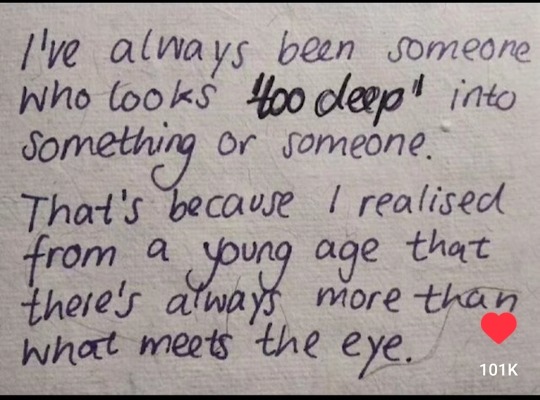#prompt stuff
Explore tagged Tumblr posts
Note
*looks at Barnaby* Mmmmmmm... You're kinda cute.
(For real, though, you draw Barnaby amazingly - I am just very easily flustered when admitting this stuff 😅)

Thank you from the artist as well!
65 notes
·
View notes
Text
🌕Frozen Hearts Beating Anew❤️🩹

My frozen heart becomes a sore lump in my chest. How I miss it's melodic beating, how I miss the warmth radiating through me whenever you called... You don't exist anymore, maybe you never existed. You were a fragment of my imagination. I need a person to save me and you were willing to put on the mask I had created. Slowly but surely, our hearts grew fond of each other... well my heart became fond of yours. I do not know your true heart, at least not anymore. As the days pass, I find I miss my version of you more and more everyday. Someday I hope to find another boy, another person who's love will help my frozen heart to beat anew.
#kaz writes#prompt stuff#sad writing#vent writing#i think i'll miss you forever core#prompt work#original writing
2 notes
·
View notes
Text
"My boy, you need to look up some YouTube tutorials "
You were once the greatest necromancer to ever exist. But millenia after being slain, you awaken to find yourself resurrected by someone clearly a novice.
7K notes
·
View notes
Text
10 Non-Lethal Injuries to Add Pain to Your Writing
New Part: 10 Lethal Injury Ideas
If you need a simple way to make your characters feel pain, here are some ideas:
1. Sprained Ankle
A common injury that can severely limit mobility. This is useful because your characters will have to experience a mild struggle and adapt their plans to their new lack of mobiliy. Perfect to add tension to a chase scene.
2. Rib Contusion
A painful bruise on the ribs can make breathing difficult, helping you sneak in those ragged wheezes during a fight scene. Could also be used for something sport-related! It's impactful enough to leave a lingering pain but not enough to hinder their overall movement.
3. Concussions
This common brain injury can lead to confusion, dizziness, and mood swings, affecting a character’s judgment heavily. It can also cause mild amnesia.
I enjoy using concussions when you need another character to subtly take over the fight/scene, it's an easy way to switch POVs. You could also use it if you need a 'cute' recovery moment with A and B.
4. Fractured Finger
A broken finger can complicate tasks that require fine motor skills. This would be perfect for characters like artists, writers, etc. Or, a fighter who brushes it off as nothing till they try to throw a punch and are hit with pain.
5. Road Rash
Road rash is an abrasion caused by friction. Aka scraping skin. The raw, painful sting resulting from a fall can be a quick but effective way to add pain to your writing. Tip: it's great if you need a mild injury for a child.
6. Shoulder Dislocation
This injury can be excruciating and often leads to an inability to use one arm, forcing characters to confront their limitations while adding urgency to their situation. Good for torture scenes.
7. Deep Laceration
A deep laceration is a cut that requires stitches. As someone who got stitches as a kid, they really aren't that bad! A 2-3 inch wound (in length) provides just enough pain and blood to add that dramatic flair to your writing while not severely deterring your character.
This is also a great wound to look back on since it often scars. Note: the deeper and wider the cut the worse your character's condition. Don't give them a 5 inch deep gash and call that mild.
8. Burns
Whether from fire, chemicals, or hot surfaces, burns can cause intense suffering and lingering trauma. Like the previous injury, the lasting physical and emotional trauma of a burn is a great wound for characters to look back on.
If you want to explore writing burns, read here.
9. Pulled Muscle
This can create ongoing pain and restrict movement, offering a window to force your character to lean on another. Note: I personally use muscle related injuries when I want to focus more on the pain and sprains to focus on a lack of mobility.
10. Tendonitis
Inflammation of a tendon can cause chronic pain and limit a character's ability to perform tasks they usually take for granted. When exploring tendonitis make sure you research well as this can easily turn into a more severe injury.
This is a quick, brief list of ideas to provide writers inspiration. Since it is a shorter blog, I have not covered the injuries in detail. This is inspiration, not a thorough guide. Happy writing! :)
Looking For More Writing Tips And Tricks?
Check out the rest of Quillology with Haya; a blog dedicated to writing and publishing tips for authors!
Instagram Tiktok
#hayatheauthor#haya's book blog#haya blogs#writing community#quillology with haya#writing tools#writer things#writing advice#writer community#writing techniques#writing prompt#writing stuff#creative writing#ya writing advice#writing tips and tricks#writer tools#writers of tumblr#writer blog#writers block#quillology with haya sameer#writers on tumblr#writerscommunity#writer stuff#author help#author advice#author#writing inspiration#writeblr#novel writing#on writing
55K notes
·
View notes
Text
“you’re a writer, right?”
me, staring at the one sentence i’ve managed to add in the last hour and the 12 open tabs on the specifics of shoes in 1845 Ireland: In theory.
#aesthetic#dark academia#poets on tumblr#writer things#poetry#prompts#ao3 writer#writblr#female writers#writeblr#writers on tumblr#writing inspiration#writing prompt#my writing#writing#writers and poets#writerscommunity#writer stuff#wip
32K notes
·
View notes
Text

#my thougts#original poem#poets on tumblr#spilled ink#dark academia#poetry#poem#prose poetry#deep thoughts#love#inspiring quotes#book quotes#quoteoftheday#quotes#love quotes#motivation#unknown#deep feelings#writing prompt#my writing#writing#writers and poets#poetic#poet#desiblr#desi aesthetic#urdu ghazal#urdu stuff
23K notes
·
View notes
Text
is that piece of media actually bad, or is it just not following the blueprint you projected onto it? is that work actually not good, or are you just demanding something from it that is absolutely antithetical to its themes, genre, tone, and narrative goal? is that story actually poorly written, or do you just dislike that it is not the specific things you wanted from it that it never set out to be, never was, and never is going to become? is it actually bad, or is it actually well-executed and you just dislike the story it chose to be because it isn't catering to your specific desires and expectations?
#This was prompted by a specific thing but it is also about dozens and dozens of things#Everyone going “XYZ is actually bad” like congratulations I wasn't saying stuff can't be bad.#I was saying that you should ask yourself these questions first bc sometimes it's just not to your sensibility.#Former Prime Queue-sector of the Trust#ETA: now that it's been months and this is going around again while certain conversations happen in other fandoms I'm in#It's good to clarify what specifically set off this post even tho it applies to many things. But this was about someone#saying Midst is thematically and narratively incoherent bc it wasn't “everyone is miserable forever and nobody gets better” like they wante
39K notes
·
View notes
Text
"AO3 doesn't need a "dislike" button"
Um, actually, it already has one. Depending on your specs, it might look a little different but over all it looks kinda like this:


You can find it at the corner of your screen, which corner is dependent on your layout.
Anyway, if you dislike a fic, you can hit this Dislike Button until the fic goes away. It really is pretty amazing actually.
#just blog stuff#ao3#this is a joke except it isn't#nothing prompted this everything is fine don't even worry about it
28K notes
·
View notes
Text
“how do you plot / plan your book?” very bold of you to assume i do that.
#i literally just make it up as i go!!#oh what happens next? I DON’T KNOW!!#writing#writer#creative writing#teen writer#author#writers on tumblr#story writing#author things#writeblr#writer stuff#book writing#bookblr#writing advice#writing prompt#on writing#writers#writer things#writers and poets#writerscommunity#writblr#female writers#author blog#author post#writing community#writing is my therapy#writing blog#writer problems#writing on tumblr
9K notes
·
View notes
Text
Welcome to my w0rkshop!
(wow! a cool new introduction post!!)
Call me Wonder! [previously known as "theghostofthething"]
Welcome to my blog! Unhinged things happen here.
Don't DM me, there's a high chance I won't respond
I am an enjoyer of many things, but I can't list them all.
Have fun scrolling, I don't post much though.
Also- Ask about anything!! Just don't be rude or weird.
~~~~~~~~~~~~~~~~~~~~~~~
#pinned post#intro post#pinned intro#blog intro#epic hall of fame of cool art#< I'ma just put this here for quick acess#folk lore / myth stuff#writing stuff#character stuff#romance stuff#dialogue stuff#prompt stuff#(anything tagged with '-stuff' is connected to writing stuff)#horror stuff#cool stuff collection#fanfic stuff#epic Tumblr quotes#plot stuff#cool movies to watch#world stuff#magic stuff#fight scene stuff#angst stuff#injury stuff#name stuff#roblox pressure things#roblox pressure pAInter#weapon stuff#show don't tell stuff#potato
1 note
·
View note
Note
🫂

41 notes
·
View notes
Text
Danny is gravely injured by the GIW, his voice box is severely damaged.
Making use of his own voice is impossible, but through some ghostly means Danny doesn’t quite understand, he can mimic others voices he hears just fine.
It’s a ghostly ability he found out he had a few years ago, with just a sentence or two heard he can do a flawless impression of that person. Now it’s not so flawless. The mimicked voice warps and fluctuates pitch, it’s crackly and he has a hard time not switching between multiple voices with every sentence he speaks.
His voice is reduced to an uncanny frankenstined attempt at speech that activates the average persons fight or flight response.
It’s no surprise that Superman is startled when he calls out for survivors while freeing the ghostly captives and a “not a deer” version of his own voice responds back.
#bones prompts#dpxdc#danny phantom#dp x dc#I’m listening to creepcasts ‘the thing in the basement is getting better at mimicking people’#and even though that creepypasta is so corny and bad I wanted to mess around with spooky mimickry Not Right voice stuff with dpxdc
6K notes
·
View notes
Text
Poison list
While it's important to approach writing with creativity and imagination, it's crucial to prioritize responsible and ethical storytelling. That being said, if you're looking for information on poisons for the purpose of writing fiction, it's essential to handle the subject matter with care and accuracy. Here is a list of some common poisons that you can use in your stories:
Hemlock: Hemlock is a highly poisonous plant that has been used as a poison in various works of literature. It can cause paralysis and respiratory failure.
Arsenic: Arsenic is a toxic element that has been historically used as a poison. It can be lethal in high doses and can cause symptoms such as vomiting, abdominal pain, and organ failure.
Cyanide: Cyanide is a fast-acting poison that affects the body's ability to use oxygen. It can cause rapid loss of consciousness and cardiac arrest.
Nightshade: Nightshade plants, such as Belladonna or Deadly Nightshade, contain toxic compounds that can cause hallucinations, respiratory distress, blurred vision, dizziness, an increased heart rate, and even death when ingested.
Ricin: Ricin is a potent poison derived from the castor bean plant. It can cause organ failure and has been used as a plot device in various fictional works.
Strychnine: Strychnine is a highly toxic alkaloid that affects the nervous system, leading to muscle spasms, convulsions, and respiratory failure.
Snake Venom: Various snake venoms can be used in fiction as deadly poisons. Different snake species have different types of venom, each with its own effects on the body.
Digitalis: Digitalis, derived from the foxglove plant, contains cardiac glycosides. It has been historically used to treat heart conditions, but in high doses, it can be toxic. Overdosing on digitalis can cause irregular heart rhythms, nausea, vomiting, and visual disturbances.
Lead: Lead poisoning, often resulting from the ingestion or inhalation of lead-based substances, has been a concern throughout history. Lead is a heavy metal that can affect the nervous system, leading to symptoms such as abdominal pain, cognitive impairment, anemia, and developmental issues, particularly in children.
Mercury: Mercury is a toxic heavy metal that has been used in various forms throughout history. Ingesting or inhaling mercury vapors can lead to mercury poisoning, causing symptoms like neurological impairment, kidney damage, respiratory issues, and gastrointestinal problems.
Aconite: Also known as Wolfsbane or Monkshood, aconite is a highly toxic plant. Its roots and leaves contain aconitine alkaloids, which can affect the heart and nervous system. Ingesting aconite can lead to symptoms like numbness, tingling, paralysis, cardiac arrhythmias, and respiratory failure.
Thallium: Thallium is a toxic heavy metal that can cause severe poisoning. It has been used as a poison due to its tastelessness and ability to mimic other substances. Thallium poisoning can lead to symptoms like hair loss, neurological issues, gastrointestinal disturbances, and damage to the kidneys and liver.
When incorporating poisons into your writing, it is essential to research and accurately portray the effects and symptoms associated with them. Additionally, be mindful of the potential impact your writing may have on readers and the importance of providing appropriate context and warnings if necessary.
If you want to read more posts about writing, please click here and give me a follow!

#creative writing#writing#writeblr#writerscommunity#writer things#writers#writersociety#on writing#writers on tumblr#writblr#writings#writer#words#write#writers and poets#writing stuff#writing tools#writing prompt#writing community#writing inspiration#writing tips#writing advice#poison type#literature#belladonna
23K notes
·
View notes
Text
So the Ghost Zone counts as its own domain right? Then I propose foreign exchange student Danny Fenton.
He's very quiet and very smart but more importantly, he's pretty dodgy about his country or origin. He's never given a straight answer about where he comes from. Only saying things like "oh we're big on combat sports" or "technically we're a monarchy but there hasn't been a king since the last one was locked away for being a tyrant". It's to the point where students have made a running bet to see who can figure out Danny's country of origin first. And Tim plans to win that bet.
#dp x dc#dc x dp#dpxdc#dcxdp#hyper prompts#danny's just trying to get an education#no need to mess that up by accidentally exposing he's a part of a race classified as “non-sentient”#but he still wants to share stuff about the ghost zone with his new friends#so half truths it is!
6K notes
·
View notes
Text
100 Dialogue Tags You Can Use Instead of “Said”
For the writers struggling to rid themselves of the classic ‘said’. Some are repeated in different categories since they fit multiple ones (but those are counted once so it adds up to 100 new words).
1. Neutral Tags
Straightforward and unobtrusive dialogue tags:
Added, Replied, Stated, Remarked, Responded, Observed, Acknowledged, Commented, Noted, Voiced, Expressed, Shared, Answered, Mentioned, Declared.
2. Questioning Tags
Curious, interrogative dialogue tags:
Asked, Queried, Wondered, Probed, Inquired, Requested, Pondered, Demanded, Challenged, Interjected, Investigated, Countered, Snapped, Pleaded, Insisted.
3. Emotive Tags
Emotional dialogue tags:
Exclaimed, Shouted, Sobbed, Whispered, Cried, Hissed, Gasped, Laughed, Screamed, Stammered, Wailed, Murmured, Snarled, Choked, Barked.
4. Descriptive Tags
Insightful, tonal dialogue tags:
Muttered, Mumbled, Yelled, Uttered, Roared, Bellowed, Drawled, Spoke, Shrieked, Boomed, Snapped, Groaned, Rasped, Purred, Croaked.
5. Action-Oriented Tags
Movement-based dialogue tags:
Announced, Admitted, Interrupted, Joked, Suggested, Offered, Explained, Repeated, Advised, Warned, Agreed, Confirmed, Ordered, Reassured, Stated.
6. Conflict Tags
Argumentative, defiant dialogue tags:
Argued, Snapped, Retorted, Rebuked, Disputed, Objected, Contested, Barked, Protested, Countered, Growled, Scoffed, Sneered, Challenged, Huffed.
7. Agreement Tags
Understanding, compliant dialogue tags:
Agreed, Assented, Nodded, Confirmed, Replied, Conceded, Acknowledged, Accepted, Affirmed, Yielded, Supported, Echoed, Consented, Promised, Concurred.
8. Disagreement Tags
Resistant, defiant dialogue tags:
Denied, Disagreed, Refused, Argued, Contradicted, Insisted, Protested, Objected, Rejected, Declined, Countered, Challenged, Snubbed, Dismissed, Rebuked.
9. Confused Tags
Hesitant, uncertain dialogue tags:
Stammered, Hesitated, Fumbled, Babbled, Mumbled, Faltered, Stumbled, Wondered, Pondered, Stuttered, Blurted, Doubted, Confessed, Vacillated.
10. Surprise Tags
Shock-inducing dialogue tags:
Gasped, Stunned, Exclaimed, Blurted, Wondered, Staggered, Marvelled, Breathed, Recoiled, Jumped, Yelped, Shrieked, Stammered.
Note: everyone is entitled to their own opinion. No I am NOT telling people to abandon said and use these. Yes I understand that said is often good enough, but sometimes you WANT to draw attention to how the character is speaking. If you think adding an action/movement to your dialogue is 'good enough' hate to break it to you but that ruins immersion much more than a casual 'mumbled'. And for the last time: this is just a resource list, CALM DOWN. Hope that covers all the annoyingly redundant replies :)
Looking For More Writing Tips And Tricks?
Check out the rest of Quillology with Haya; a blog dedicated to writing and publishing tips for authors!
Instagram Tiktok
#hayatheauthor#haya's book blog#haya blogs#writing community#quillology with haya#writing tools#writer things#writing advice#writer community#writing techniques#writing prompt#writing stuff#creative writing#ya writing advice#writing tips and tricks#writer tools#writers of tumblr#writer blog#writers block#quillology with haya sameer#writers on tumblr#writerscommunity#writer stuff#author help#author advice#author#writing inspiration#writeblr#novel writing#on writing
22K notes
·
View notes
Text
me while writing: ah yes, this character should do this, it feels so natural with what they're saying
me while editing: why the FUCK does he lean on the doorway SEVENTEEN TIMES IN THIS CHAPTER
#aesthetic#dark academia#poets on tumblr#writer things#poetry#prompts#ao3 writer#writeblr#writblr#writers on tumblr#writer stuff#female writers#writing inspiration#writing prompt#my writing#writing#writers and poets#writerscommunity#wip#writer problems
17K notes
·
View notes